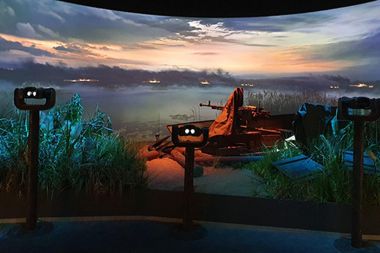WW2 museum deploys 180 Barco projectors
The projectors were deployed by Russian integrator Avilex across 1.5 km of visual installations at a museum which commemorates the heroes of the Soviet Union’s Great Patriotic War.

The new Memory Lane Museum Complex in Kubinka, Russia, honours the millions of Soviet soldiers and citizens who fought through and endured the Great Patriotic War, also known as the Eastern Front of World War Two. The Memory Lane complex is located at the heart of the 5,500 hectare Patriot Park, a military-themed visitor attraction surrounding the Main Church of the Armed Forces of Russia.
The museum, for which Barco has been a critical contributor, sets an example for other organisations that want to make an impact with visual storytelling, with 1.5 kilometres of visual installations evoking war scenes in an immersive and interactive experience. It has 35 galleries and exhibition halls, providing an immersive, interactive educational experience that relies on Barco projection technology and creative design.
The museum complex itself is 1,418 steps long – in memory of the 1,418 days and nights of battle during the Great Patriotic War and a detailed history of every day of the war is presented through the graphic timeline of the exhibition.
To realise this ambitious visualisation project, the Memory Lane Museum Complex called upon Avilex, one of Russia’s largest IT integrators, for the installation of the AV equipment. Avilex is known for taking on large, high-profile visualisation projects, although Alexey Samokhin, the company’s creative director, admits that this installation project presented an unmatched challenge.
“We are used to working with the top brands in the industry because system reliability and image quality are top priorities for all our installations,” said Samokhin. “But the biggest challenge here was the tight deadline. In mid-February 2020, we understood that more than 100 projectors would be needed and we were expected to complete the project in May 2020. Barco was the only visualisation provider that could make this work. We also succeeded thanks to close collaboration between Barco, Avilex and our distributor Auvix.”
It was planned that the museum would open on 9 May 2020, although this was postponed until 22 June because of the Covid-19 pandemic. Prior to the museum’s opening, the Avilex and Barco teams worked together relentlessly to bring the exhibition to life and translate the customer’s creative vision and requirements into visually astounding installations. The role of the distributor Auvix was also crucial, ensuring the fastest and safest delivery within the tight deadline, and made sure that all installations were finalized on time, even before the initial opening date.
The Memory Lane Museum Complex is as monumental as visually diverse: the exhibition consists of 35 galleries and immersive exhibition halls, three panoramic cinema halls, two audiovisual tunnels, break-out areas and a welcome area.
“We wanted to meet the customer’s creative requirements, but at the same time, we wanted to make the configurations for the 180 projectors as uniform as possible to make maintenance and interchangeability easier,” said Samokhin. “We were able to meet all of the requirements with a mix of Barco’s G60 series laser phosphor projectors, and F70, F80 and F90 laser phosphor projectors.”
Avilex and Barco have created quite a few unique installations for the museum. There is an installation with a crashed German plane with projection mapping, featuring Barco G60 projectors. There are five panoramic halls with 180-degree screens that create a dynamic background and physical experience, featuring G60 projectors. The museum also uses a four-channel dome projection system in the ‘Battle for the Caucasus’ hall, built into a physical, rocky scenery, using F80 projectors.
Among the most challenging installations were three ‘full immersion’ halls, each themed around a key moment from the war. The halls feature 360 degrees of projection and a screen on the ceiling. The halls’ physical construction and confined space presented limits but Barco was able to deliver a solution nonetheless.
“At first, we had no idea how we could make this installation work,” said Samokhin. “But the compact Barco F70 projector combined with an ultra-short throw lens offered a solution. We couldn’t have made this work without the help of the Barco F70.”
The museum also includes cinema halls, using three Barco F80 projectors, producing images in 4K UHD resolution.
“A creative project of this size requires perfect communication and a well-oiled team effort,” said Samokhin. “Thanks to the relentless dedication and co-ordination of the Barco team, we were able to complete this stunning visualisation project in record time. It’s a piece of art which may serve as an example to museum projects all over the world.”
Visit the AV Magazine website to stay up-to-date with all the latest AV industry news.
Posted: 18th December 2020